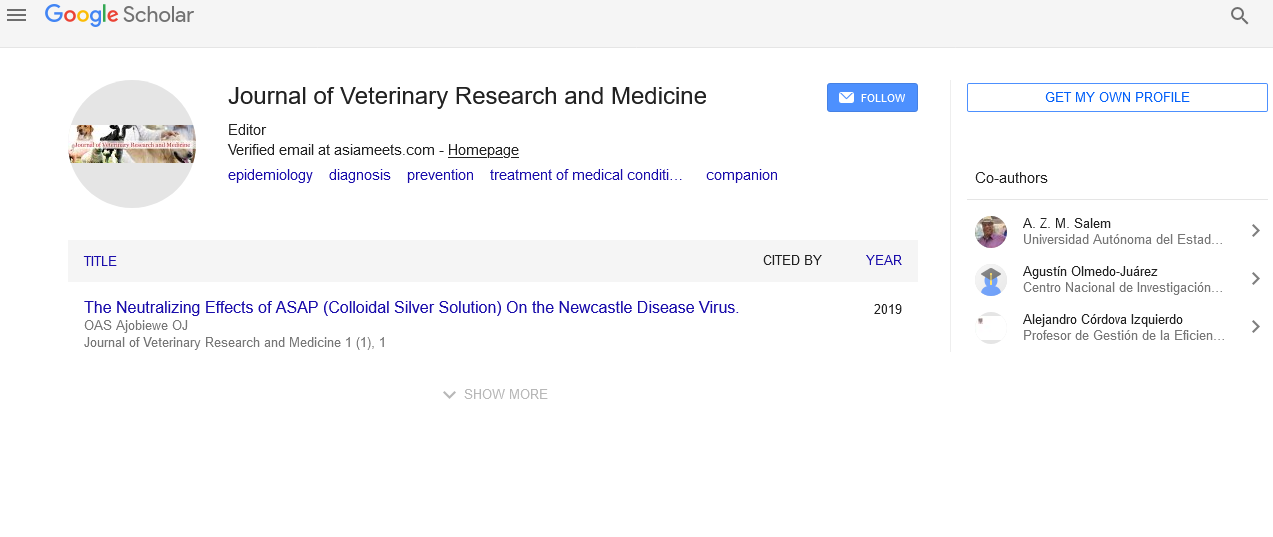Hydrophobia: Fear of Water
Received: 01-Apr-2022, Manuscript No. PULJVRP-22-4682(R); Editor assigned: 05-Apr-2022, Pre QC No. PULJVRP-22-4682(PQ); Accepted Date: Apr 11, 2022; Reviewed: 08-Apr-2022 QC No. PULJVRP-22-4682(Q); Revised: 09-Apr-2022, Manuscript No. PULJVRP-22-4682; Published: 13-Apr-2022
Citation: Johnson M. Hydrophobia: Fear of Water J Vet Res Med. 2022;4(2): 01.
This open-access article is distributed under the terms of the Creative Commons Attribution Non-Commercial License (CC BY-NC) (http://creativecommons.org/licenses/by-nc/4.0/), which permits reuse, distribution and reproduction of the article, provided that the original work is properly cited and the reuse is restricted to noncommercial purposes. For commercial reuse, contact reprints@pulsus.com
Abstract
An extreme, constantly fetal, viral polio encephalitis of worm blooded creature including human generally deadly following the beginning of clinical side effects. In up to 99% of cases, homegrown canines are liable for rabies infection transmission to people. Rabies is brought about by disease with rabies infection, or other lyssaviruses including Australian Bat Lyssavirus (ABLV), and is procured from creatures.
Key Words
Fetal; Rabies; Hydrophobia
Introduction
Rabies might be communicated by the nibble or scratch of a tainted creature infection enter the body through an injury from a nibble of crazy creature or by means of mucous film; reproduce in myocytes; spread to the neuromuscular intersection and neuro-tendinal axles travel to Center Nervous System (CNS) by means of intra-axonal liquid inside fringe nerves; at long last spreads diffusively inside fringe, tangible and engine neurons. Infection causes tens of thousands of deaths every year, mostly in Asia and Africa. 40% of people bitten by suspect rabid animals are children under 15 years of age.
The brooding time frame for rabies is normally 1-3 months yet may fluctuate from multi week to 1 year, reliant upon elements, for example, the area of infection section and viral burden; closest to CNS is more deadly and quick side effects show up. Starting side effects of rabies incorporate a fever with torment and strange or unexplained shivering, pricking, or on the other hand consuming sensation (paraesthesia) at the injury site. As the infection spreads to the CNS, moderate and lethal aggravation of the cerebrum and spinal string creates.
Background
Signs and side effects can incorporate slight or incomplete loss of motion, uneasiness, a sleeping disorder, disarray, fomentation, unusual way of behaving, neurosis, fear, and visualizations, advancing to wooziness and extreme lethargies the individual may likewise have hydrophobia (anxiety toward water). Death generally occurs 2 to 10 days after first side effects. Endurance is intriguing whenever side effects have introduced, even with the organization of appropriate and escalated care.
Rabies can be hard to analyze, in light of the fact that in the beginning phases, it is effortlessly mistaken for different illnesses or with forcefulness. The conclusion test can be taken from spit, pee and cerebrospinal liquid, yet this isn’t quite so delicate and dependable as brain samples.
Negri bodies are 100% demonstrative for rabies disease however are seen as in around 80% of cases. The strategy for diagnosing rabies is the Fluorescent Antibody Test (FAT).
The fluorescent antibody test depends on the capacity of an identifier particle (normally fluorescein iso-thiocyanate) combined with a rabies specific neutralizer, shaping a form, to tie to and permit the representation of rabies antigen utilizing fluorescent microscopy techniques.
Microscopic analysis of samples is the only direct method that allows for the identification of rabies virus-specific antigen in a short time and at a reduced cost, irrespective of geographical origin and status of the host. It has to be regarded as the first step in diagnostic procedures for all laboratories. Autolyzed samples can reduce the sensitivity and specificity of the test.
Conclusion
Rabies is quite often lethal in domestic creatures. Since of the super general wellbeing risk, treatment isn’t justified; accordingly, quarantine or euthanize all creatures associated with rabies, and inform neighborhood wellbeing division specialists. Rabies anticipation requires inoculation and forestalling pets from having contact with wild creatures.
Immunize as soon as 90 days old enough and after 1 year, then, at that point, sponsor like clockwork as per the item proposals. Maternal antibodies from immunized females will safeguard neonates until 90 days old enough. Invulnerability isn’t completely created until 28 days after the underlying rabies immunization.
Try not to immunize wild creatures or mixtures against rabies, regardless of whether they are kept as pets. The security and adequacy of parenteral rabies inoculation in untamed life and half breeds (wild creature homegrown creature crossbreds) have not been laid out, and no immunizations are authorized for these creatures.





